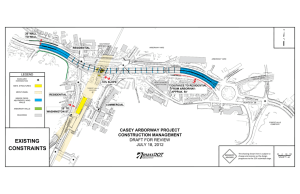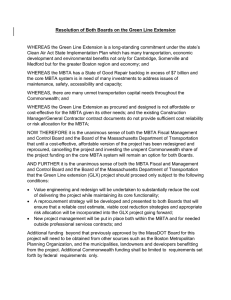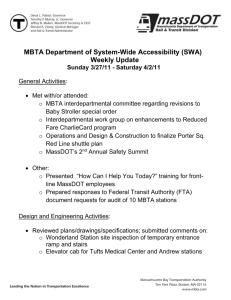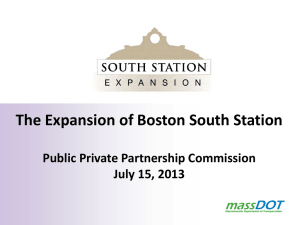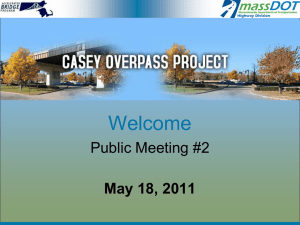Welcome Working Advisory Group Meeting #3 B June 14, 2011
advertisement
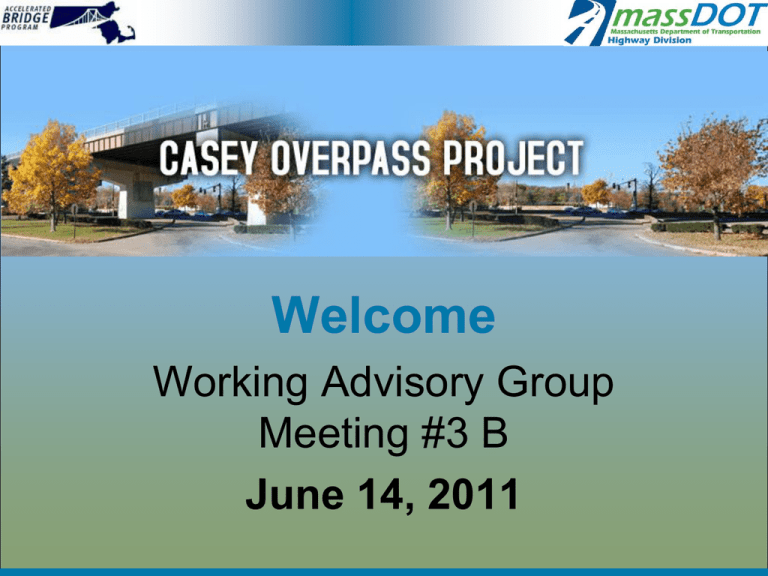
Welcome Working Advisory Group Meeting #3 B June 14, 2011 Working Group Meeting #3 A June 14, 2011 Today’s Agenda Old Business Revised Sub- Area At-Grade Options Bridge Concept Break Out: Bridge Concept with Street Evaluation Criteria – The Measures (MOEs) •Open House – Design Concepts •Public Meeting #3 Agenda –Topics and Speakers •Assignment #3 DUE Forest Hills Area - Estimated Actual Buildout: Eight Parcels 3521 Washington St (former Flanagan & Seaton) 3615 Washington St (former Hughes Oil) Arborway Yards Fitzgerald Parking Lot (New owner is LAZ Parking) MBTA Parking Lot MBTA Parcel W MBTA Parcel V MBTA Parcel U Forest Hills Area - Estimated Actual Buildout: BUILDOUT DETAILS Base Information: September 23, 2008 Final Community Recommendations estimated the following: • 375 to 461 Housing Units • 98,000 to 118,000 Retail SF • 145,000 to 356,000 Office SF Proposed development of 3529 Washington Street 2011 Updates: Actual Buildout of Parcels V & W LAZ Parking envisions building on the front / corner of the parcel Minor expansion of bus facility & new retail across Washington St. = reduced retail at Arborway Yard Estimated Actual reflects 80% of aggregate Buildout of the 2011 Update/Upper Summary: 310 to 390 Housing Units 132,000 to 165,000 Retail SF 332,000 to 416,000 Office SF 2011 Updates Forest Hills Improvement Initiative Parcels Site MBTA Parcel U MBTA Parcel V (Per Approved Plans) MBTA Parcel W (Per Approved Plans) MBTA Parcel S Station Parking Lot Fitzgerald Parking Lot (now LAZ) Note 2 Arborway Yard Parcel Note 3 Housing Units Retail/Service Area (sf) Office/Comm Area (sf) Total Bldg Area (sf) FHII Final 2011 Update / Upper 120 4,000 - 143,000 120 4,000 - 143,000 FHII Final Actual / Permitted 8 4,000 - 12,800 - 4,011 8,022 12,033 FHII Final Actual / Permitted 40 10,000 2,000 56,000 - 12,983 19,286 32,269 FHII Final 2011 Update / Upper - 42,000 169,000 211,000 - 42,000 169,000 210,000 FHII Final 2011 Update / Upper 135 15,000 - 163,000 80 15,000 - 125,000 FHII Final 2011 Update / Upper 160 45,000 128,000 348,000 160 35,000 125,000 330,000 Upper - 30,000 60,000 90,000 Upper 30 22,000 35,000 90,000 Buildout Range 2011 Update / Upper Estimated Actual Housing Retail/Service Office/Comm Total Area 390 165,000 416,000 1,032,000 310 132,000 332,000 826,000 Buildout Range Note 1 Washington St. Parcels (New) 3615 Wash. St. (Huges Oil) 3529 Wash. St. (Flan. & Seaton) All Parcels Totals Forest Hills Area – Projected Buildout: 2035 Vehicular Traffic Projections: • CTPS Regional Model: 4-12% growth in vehicular traffic • Local Developments: adds 5-10% additional vehicular traffic Peak Hour Vehicular Traffic Volumes (PM): • Forest Hills Improvement Initiative • 461 Housing Units – 55 trips • 118k Retail SF – 480 trips • 356k Office SF – 285 trips Total – 820 trips (approx 5-10% additional growth in traffic over existing volumes) •Casey Overpass Study - 2035 Projections • 310 Housing Units – • 132k Retail SF – • 332k Office SF – 40 trips 530 trips 260 trips Total – 830 trips Revised At Grade Sub–Area Design Elements New Washington Street Area The Designer General’s WARNING: The tools we use today for designing and drawing, principally AutoCAD and other software programs, make the process faster, more efficient and make coordination between drawings easier. There is an unfortunate side effect of AutoCAD which is the hard-line style makes all drawings look more finished, more thought out than they may actually be. This often leads people to incorrectly conclude that concepts and ideas shown at the early stages of a design process are finished designs. Let us assure you: this is not the case. Evaluation of Traditional Intersection Design PROS CONS Prohibition of left turns complicates access for vehicles Reconnects east-west surface street and bicyclists from Arborway to Emerald Necklace "missing link" Washington Street, South Street and Hyde Park Avenue COMMENTS The left turn prohibition from the Arborway to South St northbound could be tolerated. This is a low volume move and alternative routes exist. Access to Arborway Yard from Traditional intersection signalization Arborway would likely be more reduces confusion for all modes difficult Evaluate a mid-block crossing between Southwest Corridor Path and Forest Hills Station Provides area for increased open space The removal of the bridge restores sight lines and barriers between neighborhoods and activity centers Left turn restrictions allow for a wide and pedestrian friendly median and additional landscaping Allows for curb side queuing lane on New Washington for a taxi/bus lane Lack of a direct connection between the Southwest Corridor Park and the MBTA Station Multiple lanes for pedestrians to cross at intersections Use median space to accommodate bicyclists turning movements A wide green well-landscape median has benefits even with no path on the median. It enhances the parkway character and provides better tree growth, bio-swales for runoff and a pedestrian area. If combined with one bow-tie leg it would be much more desirable Left turn restrictions without alternative accommodations are unacceptable Evaluation of Bow Tie Design PROS Reconnects east-west surface street Emerald Necklace "missing link" Squared off intersections are easy to navigate The Bow Tie connections may improve pedestrian access to the Arboretum to the west and to Arborway Yards to the east Able to accommodate all movements within study area. Left turn decision points are located downstream of the intersection The removal of the bridge restores sight lines and barriers between neighborhoods and activity centers Removal of left turn allows for a wide and pedestrian friendly median and additional landscaping Allows for curb side queuing lane on New Washington for a taxi/bus lane CONS Adds to additional travel distance for east-west left turns for vehicles and bikes COMMENTS Analyze the eastern end of the Bow Tie interaction with outlet of Orchard Hill Rd and Morton Street Evaluate the pros and cons of a median wide enough to be a useful Multiple lanes for pedestrians pedestrian/cyclist/green space versus to cross at intersections the creation of an “empty space” similar to other landscaped medians Potential to impact curb lines Analyze bus circulation at Arboretum gate Increased number of signals on New Washington Street Evaluate the pedestrian circulation for navigating the Bow Ties Evaluate the circulation options for bicyclists move through the intersections with left turns prohibited Evaluation of Continuous Flow Design PROS CONS Reconnects east-west surface Prohibition of left turn complicates street Emerald Necklace access from Arborway eastbound to "missing link" South Street north Simplifies the turning restrictions to one movement. Highly efficient intersections move large volumes of traffic Allows for many pedestrian to cross two lanes or less Lack of pick-up/drop-off space for school buses on New Washington Street and Hyde Park Avenue COMMENTS The Arborway to South Street left turn is a low volume move and alternate routes exist. Applications of this design exists in NY, NJ, MD and several other states http://en.wikipedia.org/wiki/Continuousflow_intersection Adds more signals on New Washington Unfamiliar intersection type may cause Street and shortens the distance confusion for all modes between signals A wide green well-landscape median Left-turn decision points occur in has benefits even with no path on the advance of intersections which will median. It enhances the parkway require additional signage, sign clutter character and provides better tree and add confusion to motorist growth, bio-swales for runoff and a pedestrian area. The removal of the bridge Complicates bicycle and pedestrian Potential for wide and accessible restores sight lines and barriers access - particularly between the pedestrian median with signalization between neighborhoods and Southwest Corridor and the MBTA activity centers Potential for wrong-way entry at left-turn Additional right turn lanes may be lanes. Left turn lanes result in vehicles required to eliminate potential for wrongapproaching pedestrian crossings from way entrance into left turn lanes unexpected direction Revised At Grade Sub–Area Design Elements MBTA Station/ Washington/Asticou-South Streets Evaluation of MBTA/Washington/Asticou/South Design PROS CONS COMMENTS Provides a connection between the end of the Southwest Corridor park and the Arboretum gate to the Blackwell Path Connections between the SW Requires uses of MBTA land Corridor and both the MBTA station and reconfiguration of bus and the Arboretum are important to bays establish Extends the bicycle lanes on Washington Street, south of Ukraine Way, northward to meet the sharrows on South Street Potential impact on MBTA development parcels Left turns for bicyclists in bike lanes need to be investigated Decking over lower level increases cost The area around the north entrance to the MBTA station can be more strongly integrated with the open space network Provides curb-side space for pick-up and drop-off of MBTA patrons. This space can also be used for school bus pick-up and drop-off. Increased distance between Relocates taxi stand to the north side of the station and reconfigured bus station bays Potential negative impact on Reduces conflicts at South Street signalized Route 39 bus operations intersection Provides capacity for additional buses at Potential impact on Asticou upper level. Removes S-curve to allow for Road with increase in 60-foot articulated buses, such as the Route number of buses in 39 bus Bridge Concept with Improved Street Network Bridge View: Existing and Simple Option: (Previously Seen) Break Out Sessions Review Draft Design for Bridge Concept with Improved Street Network QUESTIONS! 1. Where should the touchdown points be located and why? 2. Where is the optimal placement for pedestrians/bicycles to maximize connections, use and functionality? 3. What is the goal for the under bridge environment? Break Out Sessions Report Back Measures of Evaluation MOEs (Evaluation Criteria) The Objectives and Their Measures MISSION STATEMENT: Provide better modal connections, reconnect the historic landscape for the Emerald Necklace, improve access and circulation for transit, pedestrian and bicycle without creating unacceptable vehicular traffic congestion/delays. Balance Mobility and Livability Goals Public Meeting #3 June 29, 2011 Working Group Participation •Part of the Presentation •Assigned Speakers For Draft Concept Designs •Agenda & Open House OPEN HOUSE Draft Agenda PROJECT OVERVIEW – Purpose and Goals DESIGN ELEMENTS- Working Group Members co-present concepts •Approach and Method •Presentation of Refined At-Grade Design Elements for 3 sub areas •Presentation of Bridge Concept DESIGN PRINCIPLES AND GOALS •Method and Process for Revisions •Mission, Principles, Goals and Objectives •Presentation of the Measures of Evaluation (MOEs) NEXT MEETING •Development of Preliminary Alternatives Assignment #3 Taking the Pulse DUE
